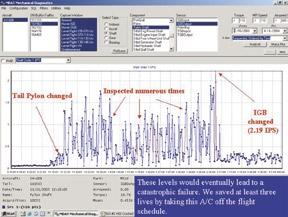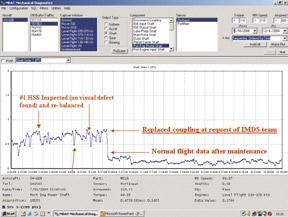
6 minute read
HSL-41 Leads DoN MFOQA Development
By Lt. Chris Morgan
Helicopter Anti-Submarine Squadron Light 41 assess the ability to integrate MFOQA processes into (HSL-41) is in the midst of a proof-of-concept naval aviation and the benefits of doing so. The core demonstration of a new knowledge-manageconcept behind HSL-41’s participation in the MFOQA ment process known as military flight operations quality process is data collection and the use of that data to assurance (MFOQA). The overall goal of MFOQA is to show measurable improvements in operational readiprovide squadron personnel and fleet leadership with ness, reduction of risk, and training standardization. To objective, quantifiable, relevant, and timely information accomplish this goal, HSL-41 is using the integrated regarding mechanical and electrical systems’ performechanical diagnostics system (IMDS), with enhanced mance, as well as aircrew performance. The MFOQA capabilities provided by the joint advanced health and process is a marked shift from traditional maintenance usage monitoring system (JAHUMS). Dr. David Haas, and standardization in that it involves proactive, nearthe technical lead for the DoN MFOQA demonstration real-time analysis of trends and performance in order at the Marine and Aviation Division, Naval Surface Warto enhance maintenance, training, standardization, and fare Center, Carderock, indicated that the Seahawks’ safety. experience with IMDS and JAHUMS technologies,
Advertisement
HSL-41 is the lead squadron for the Department of combined with their enthusiasm for using promising the Navy-sponsored MFOQA demonstration project to technologies and processes to improve their day-to-day

operations, made them the logical choice as the lead DoN MFOQA squadron for rotary-wing aircraft.
On the flightline at HSL-41, JAHUMS technologies are integrated into four aircraft. The backbone of this open architecture of technologies is the IMDS. A central processing unit collects data full time from a network of installed accelerometers. That data is supplemented by aircraft-performance data passed through the aircraft-signal processors. In addition to JAHUMS software, each aircraft has a helicopter in-flight reporting system (HIRS) and a cockpit voice flight-data recorder (CVFDR). The HIRS system provides aircraft monitoring and parameter tracking from the ground station in real time, while the CVFDR records cockpit audio.
On the ground at HSL-41, the squadron has an IMDS ground station, a JAHUMS ground station, a JAHUMS portable electronic display device (PEDD), and a 45-inch, plasma, flat-screen for realtime flight monitoring or flight playback. Aircraft data is recorded onto a PCMCIA




(memory) card during flight and then downloaded onto the IMDS ground station after the flight. Then it goes to a database on the JAHUMS ground station. Simultaneously, the data is uploaded with squadron NALCOMIS data to NAVAIR at MCAS Cherry Point. There the data is archived, and engineers perform post-flight diagnostics and trend analysis. Squadron members also can analyze the data to find trends.
After data is downloaded, and if the aircrew exceeded any engine parameters, the JAHUMS ground station launches a debrief session called the pilot debrief module (PDM). The PDM generates a sequence of questions relevant to the flight and displays them to the crew member. The crew member then can look at the data and determine if an actual malfunction occurred or if the exceedance was noted during a normal sequence of aircraft events. If no exceedances were recognized during the download, the pilot can initiate a PDM by searching for JAHUMS-supported symptoms of possible enginerelated malfunctions. The Q and A session then follows. After the debrief, a discrepancy set is created to aid diagnostics by maintenance personnel, and a maintenance work order is generated and sent to the squadron NALCOMIS system. Maintenance personnel who are assigned the work order have the ability to view the work order, the discrepancy, and the diagnostic model on the PEDD and use it to troubleshoot and correct the malfunction.

Recent lessons learned and accomplishments have shown that IMDS and JAHUMS technologies can support the development of the MFOQA process.
In 2002, during a night-vision-goggle training flight in El Centro, Calif., an engine high-speed shaft sheered, causing catastrophic damage to the engine and forcing the aircrew to land and shut down. Fortunately, the crew did not experience the malfunction while transiting over the mountains on the 60-minute flight from NAS North Island to NAF El Centro, as no pilot would like to perform an emergency landing in the mountains at night.
It is obvious that the MFOQA process would have prevented this entire evolution by removing the aircraft from the flight schedule. Unfortunately, the data from the aircraft had been sent to Cherry Point but, due to a lightning strike, was held up at a mid-tier server. It is important to note, however, that once the data was received and analyzed, engineers at Cherry Point recommended an immediate change of the high-speed shaft.
In 2003, IMDS determined that a drive-system gearbox for the tail rotor on one of the aircraft was trending out of limits. The traditional automated track and balance (ATABS) system was installed to verify the IMDS data. Initially, ATABS was unable to detect any problems. It was not until 25 minutes of constant run time that the ATABS system finally detected the discrepancy. As a result, the gearbox was removed from the aircraft. Follow-on inspections determined that the gearbox had been manufactured incorrectly. The savings to DoD: one SH-60B and a three-person aircrew.
In 2004, IMDS indicated that another high-speed shaft was trending out of limits. Several visual inspections of the shaft revealed no defects, and, each time, the shaft was rebalanced. However, by this time, the

IMDS had been expanded to allow for in-house analysis of the high-speed shaft data. As a result of this analysis, the aircraft was placed into a planned maintenance period early. Upon removal of the shaft, a visual inspection revealed an internal crack that never would have been detected while the shaft was installed. The savings to DoD: one GE-401C turboshaft engine, $676K.
The most tangible results of MFOQA at HSL-41 have been seen in the area of functional check flights following planned or major maintenance. Since HSL-41 began using IMDS and JAHUMS for FCFs, a drop in post-planned maintenance man-hours has been noted. In a single work center alone, maintenance man-hours for FCFs dropped from 81.5 man-hours to an incredible 19.4 man-hours.
One thing is for certain: HSL-41 has proven that IMDS and JAHUMS technologies, coupled with the MFOQA process, saves time, money and, most importantly, lives.
Lt. Morgan is the QA officer and flies with HSL-41.
I want to pass along that Dr. David Haas at NSWC Carderock has done a lot of work to get MFOQA to where it is today. Kurt Garbow, at the office of the deputy assistant secretary of Navy for safety, also was a strong advocate and a champion for the MFOQA program, pushing to get it implemented. In fact, he reports that on Feb. 2, 2006, the secretary of the Navy signed a policy memo implementing a directive from the office of the secretary of defense to incorporate MFOQA DoD-wide. That milestone has been long awaited, and it allows the Navy and Marine Corps to move ahead with this vital technological advance that will improve aviation and maintenance procedures, reduce costs, provide an excellent training tool, and, more importantly, potentially will save lives.—Ed.










